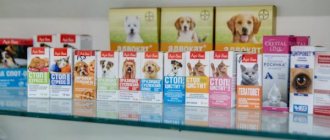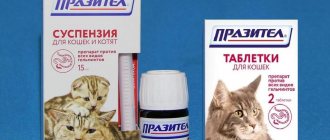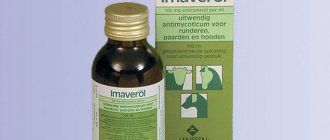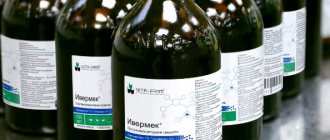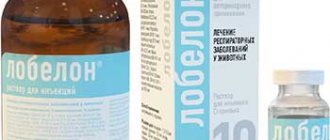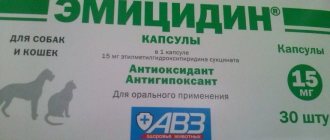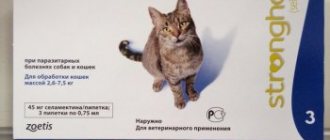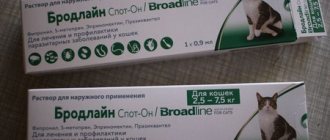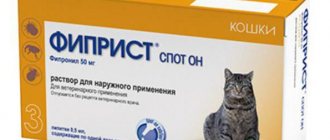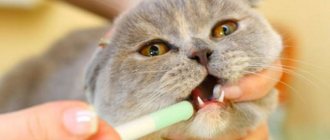Description of the drug Stop Itching
Stop-itch is a veterinary drug used in the treatment of inflammatory and allergic skin diseases. The formula of the drug was developed by a Russian pharmaceutical company (Moscow).
is one of the leading Russian manufacturers of veterinary drugs
Release form of the drug
Stop Itching is available in two dosage forms:
- spray (Stop-itch spray);
- suspension for oral use (Stop-itch suspension).
Stop-itch suspension is a homogeneous yellowish solution that tends to separate during storage. This form of the drug is available in glass bottles (volume from 10 to 100 ml) or plastic (volume from 10 to 75 ml). Each bottle is sealed with a screw cap and packed in a cardboard box along with a polymer dispenser syringe and annotation. The bottle label and box contain the following information:
- name, address and trademark of the manufacturer;
- name and volume of the drug;
- composition and storage conditions;
- series, release date (barcode) and expiration date;
- special inscriptions (“For animals”, service station, etc.);
- The box also indicates the number of bottles included, as well as the recommendation “Shake before use.”
A dosing syringe is included in each package of the drug.
Stop Itching Spray is a solution for external use, which appears as a yellow-orange liquid with blue or white tints. The drug is packaged in polymer bottles of different volumes (from 15 to 100 ml). The cap is equipped with a spray head. Each unit is packed in a cardboard box along with instructions for use. Each unit of spray contains the same information as on the suspension packaging.
The difference between the packaging boxes of the suspension and spray is the image (a kitten is drawn on the box of the suspension, a kitten and a dog are drawn on the box of the spray). Another modification of Stop Itching is a suspension for dogs, which differs from the “cat” modification only in the volume of the package. Experienced cat owners can purchase “Stop Itching for Dogs” and use it to treat their cat. This is convenient if the pharmacy does not have the required modification. The disadvantage of such a replacement is that the large bottle will not run out immediately, and the remaining medicine will have to be thrown away after the expiration date.
Stop Itching Spray can be used to treat both dogs and cats
Composition of the drug Stop Itching
The composition of 1 milliliter of oral solution includes the following substances:
- triamcinolone (glucocorticosteroid of synthetic origin) - 1 mg;
- pyridoxine hydrochloride (vitamin B) - 2 mg;
- riboflavin (water-soluble vitamin) - 4 mg;
- nicotinamide (nicotinic acid) - 10 mg;
- methionine (essential amino acid) - 20 mg;
- succinic acid - 2 mg and carboxymethylcellulose - 1.5 mg;
- Tween-80 - 6 mg (emulsifier);
- sodium benzoate (preservative) - 1.5 mg;
- potassium sorbate (water-soluble preservative) - 1.5 mg;
- cyclamate (sweetener);
- aspartame (food additive E951);
- saccharin - 1 mg;
- xanthan gum (stabilizer) - 2 mg;
- glycerin - 50 mg and distilled water - up to 1 ml.
The composition of 1 milliliter of spray includes the following components:
- triamcinolone acetonide - 0.5 mg;
- chloramphenicol (broad-spectrum antibiotic) - 5 mg;
- metronidazole (antimicrobial agent) - 10 mg;
- lidocaine hydrochloride - 50 mg;
- calendula extract, isopropyl alcohol, solvents (dimethyl sulfoxide and dimethylformamide), polyethylene glycol.
An unknowing person is usually confused by unknown names (for example, food additives with the letter “E”), although these components are found in ordinary products every day
How to properly store Stop Itching
The manufacturer's instructions say that Stop Itching is recommended to be stored under the following conditions:
- in original packaging;
- in a place protected from moisture and direct sunlight;
- separately from food and animal feed;
- isolated from children and animals;
- Storage temperature: from 0°C to 25°C.
The shelf life of the drug, regardless of its dosage form, is 2 years from the date of release.
I keep all my cat medications in a separate medicine cabinet. At first it was an old car first aid kit, but over time the medicines no longer fit in it, so I bought a simple container for household needs. Its walls are made of transparent plastic, so I store it in a closet (away from light). Along with the medicine there are also tools for caring for cats, as well as a sketchbook with all the annotations (I don’t throw away the instructions even when the medicine runs out).
Stop Itching, like any veterinary medicine, should be stored away from food and “human” medicines, for example, in a medicine cabinet or a separate container
Indications for use of Stop Itching
Stop itching is indicated for complicated dermatitis and otitis of any etiology;
- skin rash;
- itching caused by a predisposition at the genetic level or external irritants;
- weeping or dry skin diseases associated with inflammation;
- skin diseases accompanied by scratching, erosions, ulcers;
- hair loss with the formation of bald patches;
- infected dermatitis caused by insect bites.
Mechanism of action of the drug
Suspension and spray Stop Itching are combined drugs, so the pharmacological effect is achieved thanks to the complex composition of the drugs.
Triamcinolone is a powerful anti-inflammatory agent. It blocks foci of inflammation and stimulates the biosynthesis of lipokartins (proteins with anti-edematous activity). In addition, triamcinolone inhibits the production of hyaluronic acid and reduces the permeability of capillary vessels. All this helps reduce the level of penetration of allergens into the cat’s blood. Vitamins, methionine and succinic acid accelerate metabolism and improve the ability to regenerate tissue (this restores the quality of the skin).
In addition to the listed substances, the spray contains calendula extract, which allows you to quickly relieve inflammation, and lidocaine, a powerful anesthetic. Chloramphenicol and metronidazole, which are effective against most bacteria and fungi, play an important role in the treatment of dermatitis.
The effectiveness of the drug is due to its complex composition, where each component performs a therapeutic function, for example, calendula (“marigold”) has a powerful anti-inflammatory effect
Owner reviews
According to reviews from owners, “Stop Itching” acts quickly and helps the pet better tolerate the disease after just half an hour.
A positive effect is observed in more than 70% of cases. It is recommended to take precautions when applying to an animal's body. The suspension and spray are sold in convenient packages and allow you to use the medicine economically. There are isolated cases of side effects and zero effect. In particular, after treating a dog of the Dogue de Bordeaux breed, the animal began to exhibit side effects, the itching intensified, and he itched even more. However, the owner did not specify the reason for the treatment result. Perhaps the animal had contraindications, the dog had individual intolerance.
Why do dogs itch and lick?
Features of the use of Stop Itching in cats
The Stop Itch suspension should be given to the cat orally, and the spray should be sprayed onto the affected area of the skin. To safely and effectively treat your cat, you need to do the following:
- choose the right dosage;
- draw up a correct regimen for using the medication.
Application of the Stop Itching suspension
The suspension should be given to the cat only once a day. It is advisable to do this in the morning, during feeding. You can use a dosing syringe, but some owners prefer to give the medicine with food. The daily dose is calculated based on the weight of the animal. For the first 4 days the suspension is given at a therapeutic dose, and in the next 8 days the dosage should be halved. If after 12 days the desired effect is not achieved, the course of treatment can be extended (at the discretion of the veterinarian).
Some cats are very picky about food; any foreign smells and tastes completely “discourage” their appetite. In such cases, only enforcement will help. The cat needs to be secured, and the tip of the syringe must be carefully placed into the mouth (without damaging the teeth and gums). The drug must be administered quickly but smoothly (so that the cat does not choke on the solution). To prevent the cat from spitting out the medicine, you can stroke it on the neck (in the throat area) - this technique is used to stimulate reflex swallowing.
If you are going to give the suspension using a syringe, then inject the drug from the side (close to the cheek and throat)
Table: selection of a single dosage of suspension
| Cat weight | Single dose |
| From 1 to 3 kg | 0.25 ml |
| From 3 to 5 kg | 0.5 ml |
| From 5 to 10 kg | 0.75 ml |
| From 10 to 20 kg | 1 ml |
How to use Stop Itching Spray
Unlike the suspension, the Stop Itching spray is dosed not according to the weight of the cat, but according to the size of the affected area (the sore area should be moistened evenly). However, the treatment regimen depends on the disease.
Using a spray for dermatitis
For dermatitis of any etiology, it is recommended to use the spray 2 times a day. You need to treat your cat with the spray for 5–10 days (the treating veterinarian may extend the course of treatment). Before using the medicine, the skin must be cleaned of dirt (if necessary). In order for the spray to be distributed evenly, the bottle with the sprayer must be held vertically and at a distance of 10–15 cm from the surface of the skin. Essentially, the topical solution is a suspension, so shake vigorously for 20-30 seconds before use.
Some people who treated their cats with the spray reported some discomfort. The fact is that spraying is possible only with the bottle in a vertical position, and this requires that the cat sit quietly. If your pet resists and runs away, try immobilizing it. Sometimes putting a small hat or blouse on the cat helps (choose the item so that the affected area remains free). Another technique is a weak clothespin on the withers (if the skin in this area is not damaged).
When spraying, the bottle with the drug must be held strictly vertically and at a distance of 10–15 cm from the surface of the skin
Treatment of otitis media with Stop Itching spray
For otitis media, it is recommended to use the spray up to 3 times a day, the duration of the course is 5–7 days. It is important to spray the medication into the cleaned ear canal, so the cat's ears must first be cleared of scabs and dirt. If the sores in the animal’s ears are wet, then the ear canal must be thoroughly wiped.
Cats are very sensitive to the fact that someone tries to touch their ears. If your veterinarian has prescribed you a spray to treat otitis media, but you are afraid of hurting your pet, you can turn to a more experienced cat owner for help (let him help you apply the solution for 2-3 days). And the first procedure can even be carried out in a veterinary clinic.
Personal safety measures when working with medicine
When working with Stop Itching, the manufacturer recommends following a number of rules:
- when using the suspension orally or spraying the spray, do not eat, drink or smoke;
- After finishing work, hands should be washed thoroughly with warm water and soap;
- if the drug accidentally gets on the skin or eyes, they should be rinsed immediately with running water;
- if the cat’s owner is allergic to the components of the medication, then it is better to avoid using the drug;
- if a person develops allergy symptoms or if the spray/or suspension gets inside, you should immediately go to the hospital (take the instructions for use, box or bottle with you);
- Empty medicine containers cannot be used for household purposes (they must be disposed of according to general rules).
Causes of scratching
The first thing the doctor will do is examine the animal for the presence of parasites. Flea scratches appear all over the body, most often on the cheeks, neck, chin and at the base of the tail. In most cases, even if the animal has recently been treated, parasites are the cause of the itching.
The cat itches because the saliva of blood-sucking parasites always causes an allergic reaction. If you have ever been bitten by a flea or tick, you know that the bite itself is not felt, but afterwards it itches a lot. Flea saliva, injected under the skin, acts as a pain reliever, but since it has a protein base, after some time an allergic reaction occurs.
Note! The development of a flea allergy does not always imply the presence of a large number of parasites; for cats with sensitive skin, a few bites are enough for scratching to appear.
The next most popular reason is microscopic mites. Itching from mites is incomparably stronger than allergic; the area affected directly depends on the method of parasitism. For example, when infected with ear mites, a cat scratches the skin near the ear, forehead and back of the head within 24 hours. The subcutaneous mite can settle on the back, body, under the arms or even on the tail. To confirm or refute the diagnosis, a scraping is taken from the damaged skin for laboratory examination.
During laboratory analysis, scrapings are also checked for the presence of spores, which will indicate a fungal infection of the skin. Cats, dogs and people constantly have fungi and microorganisms living on their skin; not all of them are friendly, but the symbiosis is designed so that the bacteria do not attack the host. When the level of immune defense drops or an active, unfriendly culture is introduced, the cat may develop microsporia, which for many is more commonly called lichen.
Statistically, cats are more likely to get ringworm, but are practically not susceptible to other skin ailments. If the diagnosis is confirmed, the veterinarian will prescribe a course of treatment. Typically, treatment for ringworm involves injections or oral medications. Scratching should be smeared with antiseptic ointments with an antifungal effect.
Important! The symptoms of itching and allergic skin reactions are very similar (redness of the skin, itching, scratching), but are treated differently.
Can Stop Itching be used by pregnant cats and kittens?
Neither the suspension nor the Stop Itch spray should be used to treat pregnant cats and kittens weighing less than 1 kg. This drug is also not recommended for nursing females, since the active ingredients can enter the kitten’s body through milk.
Pregnant cats and small kittens should not use Stop Itching
Possible side effects and contraindications
If you follow all the manufacturer's recommendations, there will be no side effects. In some animals, hypersensitivity to the components of the drug may cause the following symptoms:
- increased salivation;
- depressed state (weakness, lethargy, etc.);
- disruption of the gastrointestinal tract (diarrhea, vomiting, etc.).
In such cases, the use of the medicine is stopped. The treating veterinarian may prescribe symptomatic medications. Salivation usually increases when the medication is taken orally (sometimes due to the viscosity of the drug). If only this unpleasant symptom occurs, then there is no need to panic; increased simplification will go away spontaneously.
If you notice signs of side effects in your cat, you should contact your veterinarian.
The following factors are contraindications to the use of Stop Itching:
- small animal weight (up to 1 kg);
- pregnancy and lactation;
- diabetes;
- viral diseases;
- individual intolerance to the components of the drug.
Sometimes complex dermatological problems arise in cats during pregnancy, so the owner often has to make a choice between safety and effectiveness. Pregnant cats are sometimes treated with Stop Itch, but this should only be done under the strict supervision of a veterinarian.
Treating scratches at home
Most often, the owner decides to observe the development of events; in the end, the cat may itch due to nervousness. If the cause is not determined correctly, the situation worsens and scratching becomes painful. The progression of the disease can be determined by the reaction of the animal, which does not allow the scratches to be examined or simply hides.
There is another scenario for the development of events - the external scratching is delayed, and the infection that has “settled” on open wounds goes into the deeper layers of the skin. This happens for two reasons - complete ignorance of the problem or treatment of the animal’s skin at random.
Simply put, when you see a scratch or scratch, you should not smear it with all the ointments that can help; it is better to adhere to the standard treatment regimen or consult a doctor. If abscesses and boils form, you need to consult a doctor, since for recovery you need to remove the infection from the deep layers of the skin as quickly as possible. If the veterinarian doubts that the cat's immune system is functioning at full strength, non-steroidal anti-inflammatory drugs may be prescribed.
Note! Scratching is called a hot spot because the body temperature in the affected areas is usually higher than the base temperature.
If the inflammation does not seem extensive or painful, treatment at home comes down to preventive measures. If you do not allow infection to occur, and the cause of scratching does not lie in illness, the wounds will heal within a few days.
To disinfect and relieve discomfort, wounds are wiped with non-alcohol tincture of calendula. It is best to buy a collection of herbs and make a decoction yourself. If you need to act quickly, and only an alcohol solution is on hand, you need to fill it with hot water or boiling water so that the alcohol evaporates as quickly as possible.
Local discomfort is successfully relieved with cool lotions. For cooling, you can use herbal decoctions - oak bark, calendula, chamomile , etc. You need to be careful with lotions because wounds need to dry out to heal. By the same logic, scratches should not be bandaged or sealed. If the cat actively licks wounds, use an Elizabethan collar or follow the regimen prescribed by the veterinarian.
Note! If a cat has scratches on its head, the use of a collar is mandatory and the main danger is not infection of the wounds, but in causing a traumatic brain injury during scratching with its paws.
If you want to rid your cat of scratching, you need to heal not the wounds, but the reasons for their appearance. The word comb comes from “to itch”, which means that the cat is bothered by itching. You need to understand that when the skin just itches, the animal does not tear the skin to the point of wounds.
Analogs of the drug Stop-itching
The following drugs are analogues of the drug Stop-itching:
- Antiches;
- Allergostop;
- Terramycin Aerosol Spray;
- Exekan.
Photo gallery: Antiches, Allergostop, Terramycin and Execan
Allergostop is one of the most popular anti-allergenic drugs, so it is available in almost any veterinary pharmacy
Antiches is a powder with the smell and taste of food (the most popular flavors are “meat and bone meal” and “milk”)
Execan is one of the most expensive analogues of Stop Itching, but it has a convenient release form
Terramycin is difficult to find in Russian pharmacies, but it is inexpensive
Comparative table: closest analogues of Stop Itching
| Name | Developer | Release form | Active ingredients | Contraindications | Side effects | Price |
| Antiches | NEC Ignatova LLP (Russia) | Powder for preparing suspension | Polcortolone and lipoic acid | Not installed | Not identified | From 90 rubles per box (60 g) |
| Allergostop | Olkar (Ukraine) | Oral suspension | Methionine and succinic acid | Pregnancy, lactation, age under 1 year, diabetes mellitus, hypersensitivity to the components of the drug | Increased salivation | From 160 rubles per bottle (15 ml) |
| Terramycin | Zoetis Inc (United States of America) | Spray for external use | Oxytetracycline hydrochloride | Allergy to tetracycline antibiotics, intolerance to drug components | Not identified | From 300 rubles per bottle (150 ml) |
| Exekan | Ceva Sante Animale (France) | Briquettes for oral administration (in the form of cubes) | Dexamethasone, vitamins and methionine | Infectious diseases, diabetes, pregnancy | In some cases, nausea, vomiting | From 800 rubles per box (16 pcs) |
